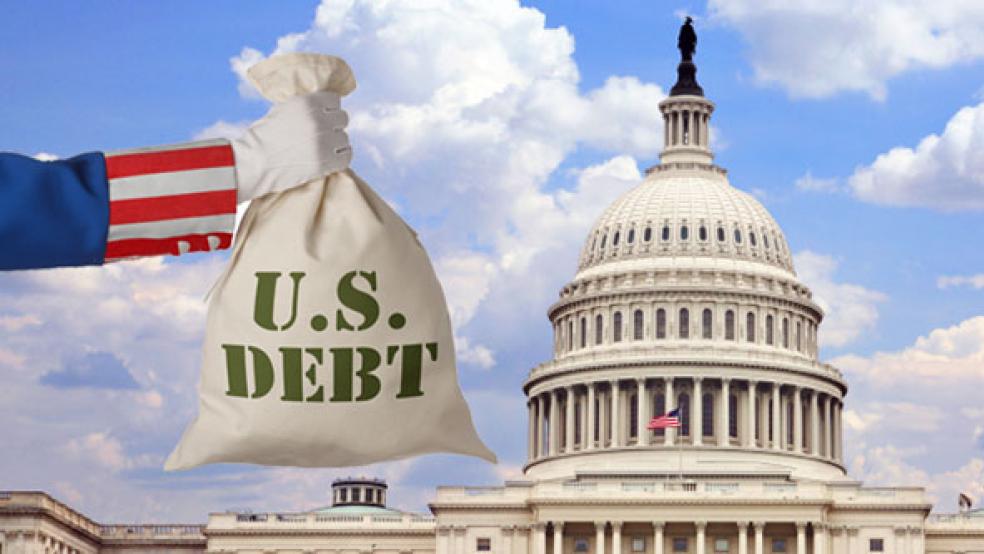With little fanfare, the Treasury Department disclosed this week that -- for the first time since 1946 -- the public debt is greater than the overall size of the U.S. economy. Budget experts said the surge in the debt ratio underscored the government’s continuing challenge to rein in spending.
U.S. debt shot up by $238 billion on Tuesday, immediately after President Obama signed a debt ceiling agreement with Congress into law. That elevated total government borrowing from outside investors to $14.57 trillion, or a little more than 100 percent of the $14.53 trillion of gross domestic product in 2010.
On Tuesday, Moody’s Investor Services warned the U.S. federal government needs to stabilize the debt-to-GDP ratio to 73 percent by the middle of the decade “to ensure that the long-run fiscal trajectory remains compatible with a AAA rating.”
Other countries whose debt exceeds its GDP include: Greece (143%) Italy (120 %) Ireland (114 %) and Japan (229%).
Between May 16, when the Treasury bumped up against its statutory borrowing authority, and TuesdayTreasury officials had to resort to a series of financial investment strategies and tricks to keep its overall borrowing beneath the debt ceiling. Once the Treasury reversed those actions, the total debt shot up. Many budget experts have used the debt to GDP ratio as a barometer of the success or failure of the government in getting its budgetary and fiscal house in order. Last December, the president’s National Commission on Fiscal Responsibility and Reform urged the White House and Congress to take steps to stabilize the debt by 2014 and reduce the debt to 60 percent of GDP by 2023 and 40 percent by 2035. Since the last time the federal budget was balanced in 2001, the federal debt has increased dramatically, rising from 33 percent of GDP to 62 percent of GDP in 2010 to slightly more than 100 percent this week.
The last time U.S. public debt exceeded the economy was when it reached unprecedented heights during World War II and peaked at almost 109 percent of GDP in 1946. It eventually fell to 32.5 percent in 1981 and averaged 37 percent of GDP from 1960 to 2000. But now, the debt is growing faster than the economy, said Steve Bell, senior director at the Bipartisan Policy Center.
In an economic slowdown, the federal government loses potential revenues because of the high number of unemployed persons not paying taxes, Bell said. On top of that, the government pays out more for automatic stabilizers—unemployment insurance, Social Security, and child nutrition programs—as a way to soften the blow of the economic downturn.
“It’s a double whammy,” Bell said. If the government doesn’t drastically change the way it operates, the U.S. economy will be headed for 200 percent of gross public debt of GDP in about 10 to 15 years, he warned. “If you look at the debt path, it’s the same as looking at the path of an airplane headed for a mountainside,” Bell said.
Bell also noted that the new deficit “super committee” tasked with finding an additional $1.5 trillion in savings over 10 years will likely have little to no impact on the net debt increase. The economy is performing more poorly than expected and the debt will likely be higher than forecast over the next decade.
Case in point: the non-partisan Congressional Budget Office projected that the U.S. economy would grow at a rate of slightly more than 3 percent in the first quarter of this year. Instead it was 0.4 percent. CBO forecasted 2.8 percent growth in the second quarter, but actual growth was 1.8 percent. These stark differences mean that substantially less in revenues will pour into federal coffers while government spending will automatically increase to cover unemployment insurance and other economic stabilizers
On Tuesday, Moody’s Investor Services warned the U.S. federal government needs to stabilize the debt-to-GDP ratio to 73 percent by the middle of the decade “to ensure that the long-run fiscal trajectory remains compatible with a AAA rating.”
Other countries whose debt exceeds its GDP include: Greece (143%) Italy (120 %) Ireland (114 %) and Japan (229%).





